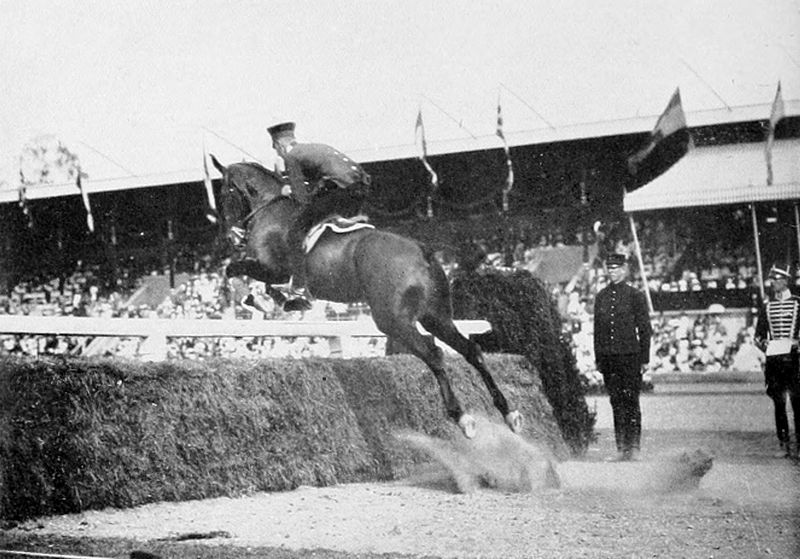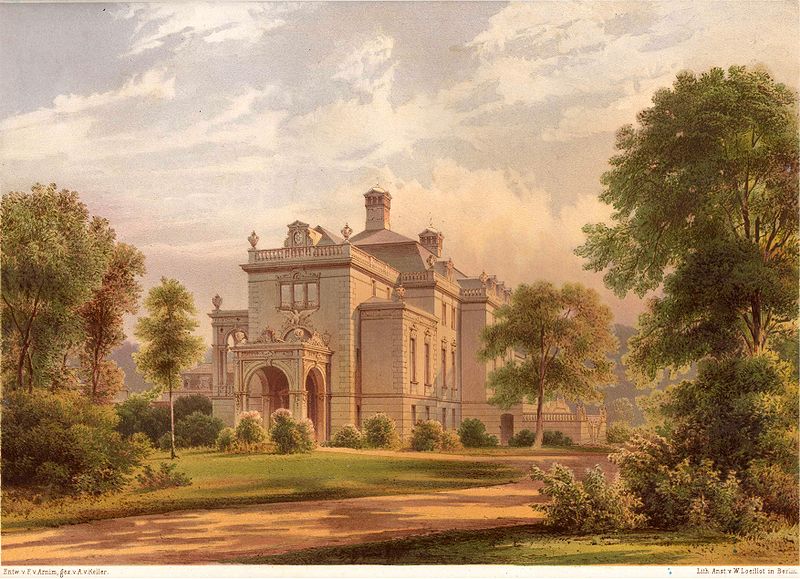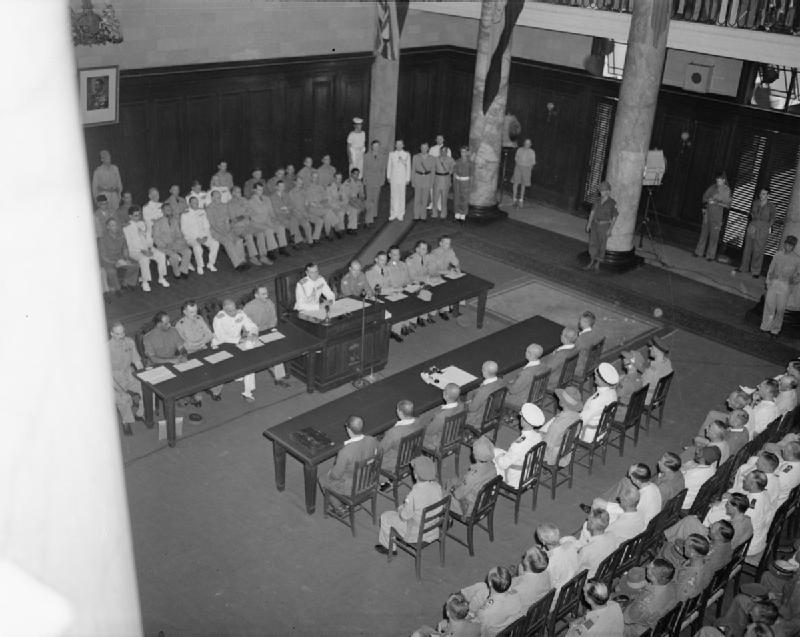by Susan Flantzer
- Prince Friedrich Karl of Prussia
- Timeline: April 1, 1917 – April 30, 1917
- A Note About German Titles
- April 1917 – Royals/Nobles/Peers/Sons of Peers Who Died In Action
**********************************************************
Prince Friedrich Karl of Prussia

Photo Credit – Wikipedia
On July 12, 1912, Prince Friedrich Karl of Prussia won a bronze medal for Germany in the equestrian team jumping event at the 1912 Summer Olympics in Stockholm, Sweden. A little more than two years later World War I began and in April 1917, the prince lost his life in the war.

Prince Friedrich Karl participating in the 1912 Summer Olympics; Photo Credit – Wikipedia
Prince Tassilo Wilhelm Humbert Leopold Friedrich Karl of Prussia, known as Friedrich Karl, was born on April 6, 1893 at Jagdschloss Glienicke, a hunting lodge now part of the Palaces and Parks of Potsdam and Berlin UNESCO World Heritage Site.

Birthplace of Prince Friedrich Karl, Jagdschloss Glienicke, by Ferdinand von Arnim, 1865; Credit – Wikipedia
Friedrich Karl was the second of the three sons and the third of the four children of Prince Friedrich Leopold of Prussia and Princess Louise Sophie of Schleswig-Holstein-Sonderburg-Augustenburg. His father was a great-grandson of King Friedrich Wilhelm III of Prussia. His mother was the granddaughter of Princess Feodora of Leiningen, Queen Victoria’s half-sister from the first marriage of her mother. Friedrich Karl was the nephew of the last German Emperor and Empress, Wilhelm II and Augusta Victoria of Schleswig-Holstein-Sonderburg-Augustenburg, who was the sister of Friedrich Karl’s mother.
Friedrich Karl had three siblings:
- Princess Victoria Margaret of Prussia (1890 – 1923), married Prince Heinrich XXXIII Reuss of Köstritz, had issue, divorced 1922, died from complications of influenza
- Prince Friedrich Sigismund of Prussia (1891 – 1927), married Princess Marie Louise of Schaumburg-Lippe, had issue, died in a riding accident during a jumping tournament after a fall from his horse
- Prince Friedrich Leopold of Prussia (1895 -1959), unmarried, prisoner in the Dachau concentration camp during World War II
Like all princes of the Prussian royal house, Friedrich Karl, at the age of ten, was given the rank of lieutenant à la suite in the 1st Regiment of Foot Guards. À la suite is a military term that identifies persons who are entitled to bear a regimental uniform, but who have no official position. By 1908, the prince was an official member of the 1st Regiment of Foot Guards with the rank of lieutenant.
Prince Friedrich Karl participated in the 1912 Summer Olympics in Stockholm, Sweden as a member of the German equestrian team. He won a bronze medal riding his horse Gibson Boy in the team jumping event. Because of the close connection between the equestrian events and the skills required in the military, only active officers represented their country riding their own service horses.

Germany’s bronze medal winning team in the team jumping event: Prince Friedrich Karl, Lieutenant Ernst Deloch, Lieutenant Sigismund Freyer, Lieutenant Wilhelm, Graf von Hohenau; Photo Credit – Wikipedia
During World War I, Prince Friedrich Karl served with the Imperial German Army, the combined land and air forces of the German Empire, as the captain (Rittmeister) of the Fliegerabteilung (Artillerie) 258, an aerial artillery spotting unit. In addition to his regular duties, the prince often flew his Albatros D.I, a German single-seater fighter aircraft, on patrols with the Jagdstaffel 2, one of the best-known German air squadrons in World War I
On March 21, 1917, British World War I flying ace Charles Pickthorn forced down a German Albatros D.I with a skull and crossbones insignia behind the British lines at Lagnicourt, France. Once on the ground, the German pilot attempted to run toward the German lines, but was shot in the back and severely wounded by Australian troops. The pilot turned out to be Prince Friedrich Karl.

Albatros D.I flown by Prince Friedrich Karl surrounded by a group of mostly Australians soldiers presumably the ones who had captured him; Photo Credit – Project 914 Archives
A German military report of March 22, 1917 said: “The aircraft operated by Prince Friedrich Karl of Prussia has not returned from a flight over the enemy lines between Arras and Péronne.” The prince was taken into captivity and he died from his injuries on his 24th birthday, April 6, 1917, at the British military hospital in St. Etienne du Rouvray, France. The prince was given a funeral befitting his military rank of Rittmeister. A division of 100 soldiers made up the funeral procession along with a band that played a mourning march. The prince was buried in the cemetery in St. Etienne du Rouvray. Two clergymen prayed at his grave and three volleys were fired. The British Air Corps donated two wreaths for his grave where a wooden cross with his name and dates was erected.
********************
Timeline: April 1, 1916 – April 30, 1917
- April 2 – 3 – Australians attack Noreuil in France
- April 6 – United States declares war on Germany
- April 9 – May 17 – Second Battle of Arras in Arras, France, British attack a heavily fortified German line without obtaining any strategic breakthrough
- April 9 – 12 – Canadians obtain a significant victory in the Battle of Vimy Ridge in Vimy, Pas-de-Calais, France, part of the first phase of the Second Battle of Arras
- April 9 – 14 – First Battle of the Scarpe near Arras, France, part of the first phase of the Second Battle of Arras
- April 10 – 11 – First Battle of Bullecourt near Arras, France, part of the first phase of the Second Battle of Arras
- April 15 – Battle of Lagnicourt in Lagnicourt, France, part of the Second phase of the Second Battle of Arras
- April 16 – May 9 – Second Battle of the Aisne between Soissons and Reims, France, ends in disaster for the French army
- April 17 – 20 – Battle of the Hills in Champagne Province, France, a diversion to the Second Battle of the Aisne
- April 19 – Second Battle of Gaza in Gaza, Palestine (now in the Gaza Strip), the Ottoman lines resist a British attack
- April 22 – May 8 – Second Battle of Doiran near Lake Dojran, Kingdom of Serbia (present-day Macedonia)
- April 23 – 24 – Second Battle of Scarpe near Arras, France, part of the second phase of the Second Battle of Arras
- April 28 – 29 – Battle of Arleux near Arras, France, part of the second phase of the Second Battle of Arras
- April 29 – May 20 – Series of mutinies in the French army
********************
A Note About German Titles
Many German royals and nobles died in World War I. The German Empire consisted of 27 constituent states, most of them ruled by royal families. Scroll down to German Empire here to see what constituent states made up the German Empire. The constituent states retained their own governments, but had limited sovereignty. Some had their own armies, but the military forces of the smaller ones were put under Prussian control. In wartime, armies of all the constituent states would be controlled by the Prussian Army and the combined forces were known as the Imperial German Army. German titles may be used in Royals Who Died In Action below. Refer to Unofficial Royalty: Glossary of German Noble and Royal Titles.
24 British peers were also killed in World War I and they will be included in the list of those who died in action. In addition, more than 100 sons of peers also lost their lives, and those that can be verified will also be included.
********************
April 1917 – Royals/Nobles/Peers/Sons of Peers Who Died In Action
The list is in chronological order and does contain some who would be considered noble instead of royal. The links in the last bullet for each person is that person’s genealogical information from Leo’s Genealogics Website or to The Peerage website If a person has a Wikipedia page or a website page with biographical information, their name will be linked to that page.
Captain Richard Godolphin Hume Chaloner
- elder son of Richard Chaloner, 1st Baron Gisborough and Margaret Brocklesby Davis
- born June 29, 1883 in Marylebone, London, England
- married 1914 Evelyn Maud Benyon, had one daughter
- Captain in the 3rd Battalion, Wiltshire Regiment, attached to the Number 20 Prisoner of War Company
- killed by friendly fire from one of his own sentries during a storm at night April 3, 1917 in Calais, France, age 33
- buried at Calais Southern Cemetery in Calais, France
- http://www.thepeerage.com/p19395.htm#i193943
********************
Prince Friedrich Karl of Prussia (see above)

Photo Credit – Wikipedia
- son of Prince Friedrich Leopold of Prussia and Princess Louise Sophie of Schleswig-Holstein
- born April 6, 1893 at Schloss Klein-Glienicke in Berlin, Prussia
- unmarried
- Bronze Medalist in the equestrian team jumping event in the 1912 Summer Olympics
- died from wounds received in action April 6, 1917 at Saint-Étienne-du-Rouvray, France, age 24
********************
Lieutenant The Honorable George Seymour Dawson-Damer
- son of Lionel George Henry Seymour Dawson-Damer, 5th Earl of Portarlington and Emma Andalusia Frere Kennedy
- born June 30, 1892
- unmarried
- Lieutenant in the 10th Hussars and Dorset Yeomanry
- died April 12, 1917 from wounds received in a cavalry charge in the Battle of Arras in Arras, France , age 24
- http://thepeerage.com/p5460.htm#i54592
********************
Richard Bernard Boyle, 7th Earl of Shannon
- son of Richard Henry Boyle, 6th Earl of Shannon and Nellie Thompson
- born November 13, 1897
- unmarried
- died April 13, 1917 in the Battle of Arras in Arras, France, age 19
- http://www.thepeerage.com/p7264.htm#i72638
********************
2nd Lieutenant The Honorable Charles Willoughby Murray Molesworth
- only son of George Bagot Molesworth, 9th Viscount Molesworth of Swords and Nina Alida Faulkner
- born November 21, 1897
unmarried - 2nd Lieutenant in the Duke of Cornwall’s Light Infantry
- died from wounds received while carrying out a reconnaissance in “no man’s land” in action April 15, 1917, age 19
- buried at Villiers Station Cemetery, Villiers-au-Bois
- http://www.thepeerage.com/p51495.htm#i514950
********************
Henry Molyneux Paget Howard, 19th Earl of Suffolk
- son of Henry Charles Howard, 18th Earl of Suffolk and Mary Eleanor Lauderdale Coventry
- born September 13, 1877
- married 1904 Margaret Hyde Leiter, had three sons, the eldest son Charles Howard, 20th Earl of Suffolk, a bomb disposal expert, was killed while defusing an unexploded bomb during the London Blitz in World War II
- Major in command of the Wiltshire Battery, 3rd Wessex Brigade, Royal Field Artillery
- killed in action by shrapnel through the heart at the Battle of Istabulat in Istabulat, Iraq on
- April 21, 1917, age 39
- buried at Basra War Cemetery, Iraq
- http://www.thepeerage.com/p4905.htm#i49050






























